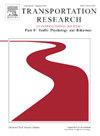Demographic risk factors and injury severity scores in Substance-use behaviour related traffic crashes
IF 4.4
2区 工程技术
Q1 PSYCHOLOGY, APPLIED
Transportation Research Part F-Traffic Psychology and Behaviour
Pub Date : 2024-11-29
DOI:10.1016/j.trf.2024.11.018
引用次数: 0
Abstract
Alcohol and drugs, including Tetrahydrocannabinol (THC), significantly impact roadway safety by impairing cognitive functions, coordination, and reaction times, leading to increased crash risk and severity. This study examines the prevalence of alcohol and drugs among 4,586 injured roadway users (drivers, riders, and passengers) in the U.S. from 2019 to 2021, utilizing an XGBoost model to identify key variables associated with Injury Severity Score (ISS) in substance-related traffic crashes, and highlighting influential factors such as injury location, demographic characteristics (age, race), safety compliance, and alcohol and drug presence. These risk factors were further analyzed through Cluster Correspondence Analysis (CCA) to reveal patterns and trends affecting injury severity across different demographic and behavioral groups. The findings reveal that 55.8% of the injured tested positive for substances, with cannabinoids being the most common, followed by alcohol, stimulants, and opioids. This study identified six core crash clusters, each with distinct characteristics, including older drivers, impaired young drivers, specific driver ethnicities, and motorcyclists. Key findings from clusters indicate that older drivers, despite high safety compliance and negative substance tests, faced crash risks potentially due to age-related limitations. Impaired young adult crashes are characterized by risky behavior, including alcohol and THC use combined with low safety compliance, while motorcyclists with high substance involvement and inconsistent helmet use, are identified as a high-risk group, frequently experiencing severe leg injuries. These insights underscore the need for comprehensive traffic safety policies targeting substance use and promoting effective safety measures to mitigate crash risks and improve road safety.
与物质使用行为相关的交通事故中的人口危险因素和伤害严重程度评分
酒精和毒品,包括四氢大麻酚(THC),会损害认知功能、协调能力和反应时间,从而严重影响道路安全,导致撞车风险和严重程度增加。本研究调查了2019年至2021年美国4586名受伤道路使用者(司机、乘客和乘客)中酒精和药物的患病率,利用XGBoost模型确定与物质相关交通事故中伤害严重程度评分(ISS)相关的关键变量,并突出了伤害位置、人口特征(年龄、种族)、安全合规以及酒精和药物存在等影响因素。通过聚类对应分析(CCA)进一步分析这些危险因素,揭示影响不同人口统计和行为群体损伤严重程度的模式和趋势。调查结果显示,55.8%的伤者的药物检测呈阳性,大麻素是最常见的,其次是酒精、兴奋剂和阿片类药物。这项研究确定了六个核心碰撞集群,每个集群都有不同的特征,包括老年司机、残疾的年轻司机、特定的司机种族和摩托车手。来自集群的主要调查结果表明,尽管老年司机的安全合规程度很高,并且进行了阴性物质测试,但由于与年龄有关的限制,他们可能面临撞车风险。受损青年碰撞事故的特点是危险行为,包括酒精和四氢大麻酚的使用以及低安全依从性,而大量使用药物和不一致使用头盔的摩托车手被确定为高风险群体,经常遭受严重的腿部损伤。这些见解强调需要制定针对药物使用的综合交通安全政策,并促进有效的安全措施,以减轻碰撞风险并改善道路安全。
本文章由计算机程序翻译,如有差异,请以英文原文为准。
求助全文
约1分钟内获得全文
求助全文
来源期刊
CiteScore
7.60
自引率
14.60%
发文量
239
审稿时长
71 days
期刊介绍:
Transportation Research Part F: Traffic Psychology and Behaviour focuses on the behavioural and psychological aspects of traffic and transport. The aim of the journal is to enhance theory development, improve the quality of empirical studies and to stimulate the application of research findings in practice. TRF provides a focus and a means of communication for the considerable amount of research activities that are now being carried out in this field. The journal provides a forum for transportation researchers, psychologists, ergonomists, engineers and policy-makers with an interest in traffic and transport psychology.

 求助内容:
求助内容: 应助结果提醒方式:
应助结果提醒方式:


